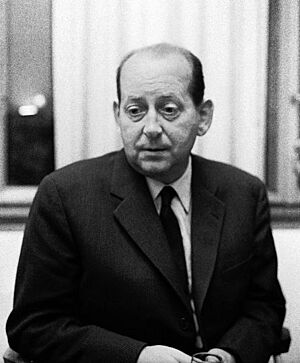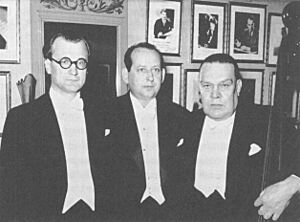Eduard Tubin facts for kids
Quick facts for kids
Eduard Tubin
|
|
|---|---|

1958
|
|
| Born | 18 June 1905 Torila, Tartu County, Governorate of Livonia, Russian Empire
|
| Died | 17 November 1982 (aged 77) |
| Occupation | Composer, conductor |
| Years active | 1932–1982 |
| Spouse(s) |
|
Eduard Tubin (born June 18, 1905 – died November 17, 1982) was an Estonian composer and conductor. He also worked as a choreographer.
Contents
Life Story of Eduard Tubin
Eduard Tubin was born in a place called Torila, in what was then the Russian Empire. His parents loved music, and his father even played the trombone in the village band. Eduard's first musical experience was learning the flute at school. Later, his father traded a cow for a piano! Young Eduard quickly became known in his village for his piano playing. He also played the flute in the village orchestra.
Early Music Education
In 1920, Tubin started at the Tartu Teacher's College in Estonia, which had just become an independent country. Here, he became very interested in writing his own music. In 1924, he joined the Tartu Higher Music School. He studied under Heino Eller, a famous Estonian composer.
In 1930, Tubin married Linda Pirn, who was also a student there. Their son, Rein, was born in 1932. Tubin started working as a conductor at the Vanemuine theatre. He also led a well-known male choir and traveled abroad several times. In 1938, he met Zoltán Kodály in Hungary. Kodály encouraged Tubin's interest in folk songs. In 1941, Eduard married a ballet dancer named Elfriede Saarik. Their son, Eino, was born in 1942.

Moving to Sweden
In 1944, Estonia came under Soviet control again. Tubin decided to leave Estonia and moved to Stockholm, Sweden, with his wife Erika and sons Rein and Eino. He stayed in Sweden and became a Swedish citizen in 1961. However, he did visit Estonia sometimes.
In Sweden, he found work at the historic Drottningholm Palace Theatre. His job was to help restore old operas. This work gave him time to focus on writing his own music. He composed many of his most important pieces here. These included two operas, several symphonies (numbers 5 to 10), and concertos for different instruments like the violin, double-bass, and balalaika. He also wrote music for piano, violin, choirs, and solo singers.
Later Life and Recognition
Towards the end of his life, Tubin slowly started to become more famous. This happened especially after the conductor Neeme Järvi, who was also Estonian, moved to the United States in 1980. In his last year, his Tenth Symphony was performed five times by the Boston Symphony Orchestra.
Tubin received several music awards in Sweden. He was also chosen as a member of the Royal Swedish Academy of Music. After a long illness, he passed away on November 17, 1982, in Stockholm.
Tubin's Musical Style
Eduard Tubin often used Estonian folk music in his compositions. For example, his Sinfonietta on Estonian Motifs uses these traditional sounds. His ballet Kratt is entirely based on Estonian folk tunes. In 1938, Tubin even visited the Estonian island of Hiiumaa to collect folk songs. Tubin was also very skilled at arranging music for orchestras. You can hear this especially in his Third and Fourth symphonies.
Changes in His Music
Tubin's musical style changed in the late 1940s. His music became more complex in its harmonies. For example, the end of his Seventh Symphony uses a theme with all twelve notes of the musical scale, but it still sounds like it has a main key. This shift to a less national (Estonian) and more international style happened after he moved from Estonia to Sweden.

Tubin might not be as well-known as some other composers because he had to leave his home country. Even though Estonia considers him one of its greatest composers, he wrote most of his music in Sweden. Sweden, however, didn't always give him the attention he deserved.
Still, Tubin is gaining more recognition today. His later symphonies and his Second Piano Sonata are now seen as masterpieces. Most of his works have been recorded. There are even two full sets of his symphonies recorded by conductors Neeme Järvi and Arvo Volmer. In June 2005, the city of Tallinn celebrated 100 years since his birth with a festival. All of his symphonies and much of his piano and chamber music were performed. A statue of Tubin was also put up in Tartu.
Tubin Museum and Society
A museum dedicated to Tubin opened in 2011 at Alatskivi Castle, close to where he was born. It has exhibits about the composer and other musicians from the "Tartu school." These were musicians who studied under Heino Eller, including Alfred Karindi, Eduard Oja, Olav Roots, and Karl Leichter.
The International Eduard Tubin Society was started in Estonia in 2000. Its main goal is to create a complete and accurate collection of all his works. This important project is still ongoing.
Selected Musical Works
Here are some of Eduard Tubin's most important musical pieces:
- Orchestra Music
- Symphony No. 1 in C minor (1931–1934)
- Symphony No. 2 in B minor "Legendary" (1937)
- Symphony No. 3 in D minor "Heroic" (1940–1942, revised 1968)
- Symphony No. 4 in A "Lyrical" (1943, revised 1978)
- Symphony No. 5 in B minor (1946)
- Symphony No. 6 (1953–1954, revised 1956)
- Symphony No. 7 (1955–1958)
- Symphony No. 8 (1965–1966)
- Symphony No. 9 "Sinfonia semplice" (1969)
- Symphony No. 10 (1973)
- Suite on Estonian Themes (1929–30)
- Toccata (1937)
- Prelude Solennel (1940)
- Sinfonietta on Estonian Motifs (1940)
- Music for Strings (1962–1963)
- Concertos (Music for Solo Instrument and Orchestra)
- Violin Concerto No. 1 in D major (1941–1942)
- Concertino for Piano and Orchestra (1944–1945)
- Violin Concerto No. 2 in G minor (1945)
- Double Bass Concerto (1948)
- Balalaika Concerto (1963–1964)
- Opera, Ballet, and Choral Works
- Kratt, ballet in 4 acts (1938–1940, revised 1959–1960)
- Inauguration Cantata for baritone, reciter, chorus and orchestra (1958)
- Barbara von Tisenhusen, opera in 3 acts (1967–1968)
- The Parson of Reigi (Reigi õpetaja), opera (1970–1971)
- Requiem for Fallen Soldiers (1950, revised 1979)
- Chamber Music (for Small Groups of Instruments)
- Piano Sonata No.1 (1928)
- Piano Sonata No. 2 "Northern Lights" (1950)
- Violin Sonata No.1 (1934–1936, revised 1968–1969)
- Capriccio No.1 for Violin and Piano (1937, revised 1971)
- Pastorale for Viola and Organ (1956)
- Viola Sonata (1964–1965)
- Alto Saxophone Sonata (1951)
- Piano Quartet in C sharp minor (1929–30)
- String Quartet (1979)
See also
 In Spanish: Eduard Tubin para niños
In Spanish: Eduard Tubin para niños

